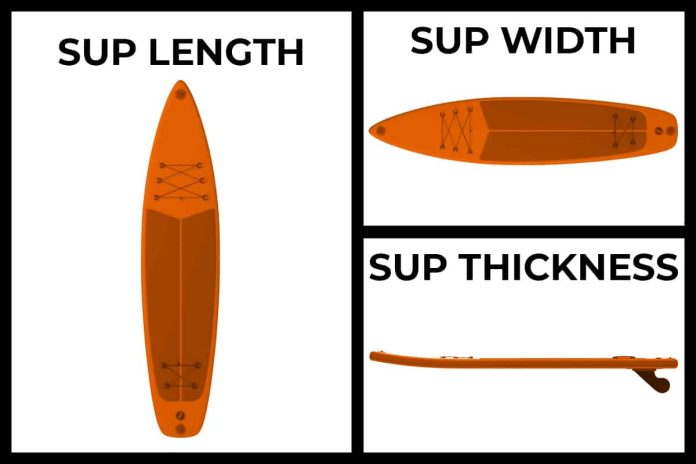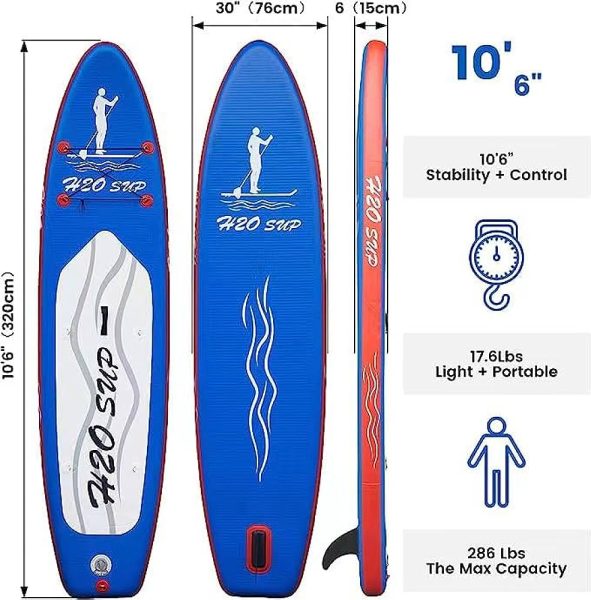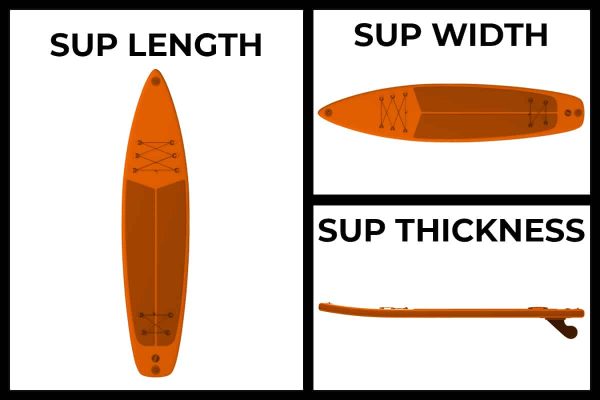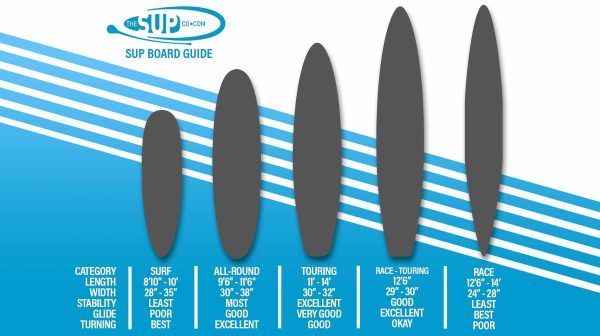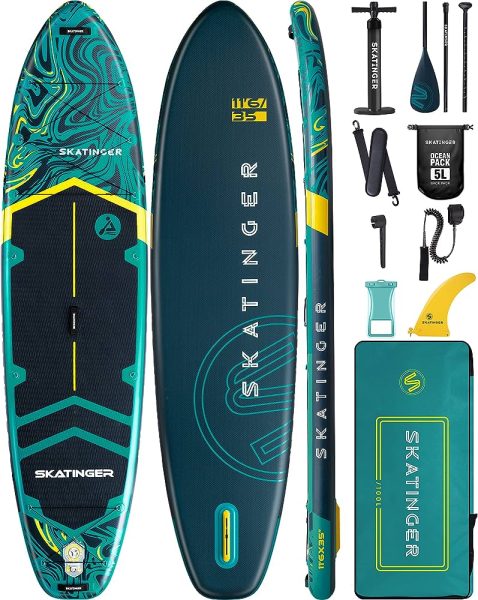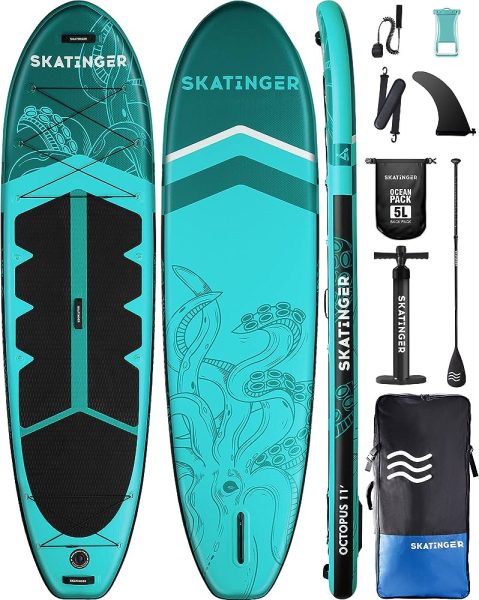Looking for the perfect stand up paddle (SUP) board that will keep you stable on the water? Look no further! In this article, we will discuss the ideal width of a stable SUP board.
Whether you’re a beginner or an experienced paddler, finding the correct width can make all the difference in your paddling experience.
So, let’s explore the importance of width when choosing a stable SUP board and uncover the perfect width for your next adventure on the water.
Factors Affecting Stability
Stability is a crucial factor in choosing a stand-up paddleboard (SUP). Several factors can impact the stability of a SUP board, including board width, length, and thickness. In this article, we will explore each of these factors in detail and discuss how they affect the stability of an SUP board.
Board Width
Board width is one of the most significant factors affecting a SUP board’s stability. The width of a board refers to the distance between its rails or sides. Generally, a wider board offers more stability than a narrower one. A wider board provides a larger surface area for paddlers to stand on, allowing for improved balance and stability.
Standard Width Range
In the world of SUP boards, manufacturers follow a standard width range. This range typically spans from around 29 to 36 inches. You will find various board widths within this range to suit different paddling needs and preferences.
Narrow SUP Boards
Narrow SUP boards, typically around 29 to 31 inches in width, are designed for more experienced paddlers prioritizing speed and maneuverability over stability. Due to their narrower width, these boards may require more skill to maintain balance. However, they offer incredible speed and agility, making them suitable for activities like racing or surfing.
Wide SUP Boards
On the other end of the spectrum, wide SUP boards, ranging from 32 to 36 inches in width, are ideal for beginners or those prioritizing stability above all else. These boards offer a more generous platform for paddlers and provide excellent stability, making them perfect for leisurely paddling, yoga, or SUP activities where maintaining balance is critical.
This image is the property of Amazon.com.
Importance of Board Width
Now that we understand the various width ranges and their suitability for different paddling needs let’s delve deeper into the importance of board width for stability.
Primary Determinant of Stability
Out of all the factors that influence stability, board width is arguably the primary determinant. This is because the more comprehensive the board, the more stability it offers. Wide boards ensure the paddler has a solid and secure platform to stand on, reducing the likelihood of accidental falls or imbalance during paddling.
Impact on Maneuverability
While a wider board may offer excellent stability, it may slightly compromise maneuverability compared to narrower boards. This is because a wider board has more surface area in contact with the water, creating more drag and slightly slowing down the board’s responsiveness. However, for most paddlers, the slight reduction in maneuverability is a worthwhile trade-off for the increased stability it provides.
Impact on Speed
Another factor affected by board width is speed. Narrower boards are generally faster due to their sleeker design and reduced drag on the water. A narrower board may be the better choice if your primary focus is speed. However, it’s important to note that speed may come at the expense of stability.
Choosing the Right Board Width
When it comes to choosing the correct board width, several factors need to be considered. Let’s explore these factors to help you make an informed decision.
Skill Level and Experience
Your skill level and experience as a paddler are crucial in determining the optimal board width for you. Beginners or those with limited experience may benefit from wider SUP boards that offer enhanced stability and confidence on the water. As you gain more experience and improve your balance and paddling skills, you may consider transitioning to a narrower board for increased maneuverability and speed.
Paddling Location and Conditions
The location where you plan to paddle and the prevailing conditions also impact the ideal board width for your needs. A wider board may be suitable if you primarily paddle in calm, flat water or mild conditions. However, if you often encounter choppy water or stronger currents, a narrower board may be more appropriate to navigate rougher conditions more easily.
Personal Preference
Ultimately, personal preference plays a significant role in board width selection. Some paddlers prioritize stability above all else and feel more comfortable on wider boards, while others may value speed or maneuverability and opt for narrower boards. It’s essential to consider your preferences and goals as you decide.
This image is the property of paddlecamp.com.
Additional Considerations
While board width is an essential factor to consider, a few additional considerations should be considered when choosing a SUP board for optimal stability.
Weight Capacity
Each SUP board has a recommended weight capacity, indicating the maximum weight the board can support while maintaining stability. Selecting a board that can comfortably accommodate your weight is crucial, as exceeding the weight capacity can compromise stability and performance.
Paddler Size
Paddler size also plays a role in determining the ideal board width. Taller or larger individuals may benefit from wider boards to ensure enough space and stability to stand comfortably. Likewise, smaller paddlers may find narrower boards more suitable for their body proportions.
Design and Features
Board design and features can also impact stability. Some boards incorporate additional stability features, such as wider tails or squared-off edges, to enhance stability in rougher water or challenging conditions. It’s worth exploring different board designs and features to find the right combination that meets your stability requirements.
Factors to Balance
When choosing a SUP board, it’s essential to balance stability with other factors that may be important to you, such as performance or portability.
Stability vs. Performance
While stability is crucial, it may need to be balanced against performance, especially if you are an experienced paddler seeking a more dynamic SUP experience. Narrower boards typically offer better performance, such as increased speed or maneuverability, but may sacrifice some stability. Finding the right balance between stability and performance depends on your skill level and specific needs.
Stability vs. Portability
Another factor to balance is stability against portability. Wider boards tend to be bulkier and heavier, which may impact their portability and ease of transportation. If you prioritize portability and need a board that is easily transported or stored, a narrower board may be more suitable. However, remember that this may come at the expense of some stability.
This image is the property of www.thesupco.com.
Alternative Stability Features
While board width is the primary factor affecting stability, there are alternative stability features to consider when selecting a SUP board.
Longitudinal Stability
Longitudinal stability refers to the stability of a board along its length or nose-to-tail axis. Some boards incorporate additional volume in the nose or tail sections to enhance longitudinal stability. This can improve stability, especially when paddling in choppy water or performing quick turns.
Planing Hull Design
Boards with a planing hull design are often more stable than those with a displacement hull design. Planing hulls have a flatter, wider shape, which helps distribute the paddler’s weight more evenly and increases stability. However, it’s important to note that planing hulls may sacrifice some speed and efficiency compared to displacement hulls.
Board Width and SUP Activities
The optimal board width for your SUP activities depends on the specific activities you plan. Let’s explore how board width relates to some popular SUP activities.
Touring and Cruising
A broad board is usually preferred for touring or cruising activities where you’ll spend extended periods on the water. These boards provide excellent stability, allowing you to comfortably paddle for long distances without sacrificing balance. Additionally, their more comprehensive platforms offer ample space to carry gear or equipment for longer outings.
Racing
In SUP racing, narrower boards are the go-to choice for experienced racers seeking top speed and maneuverability. Although narrower boards may require more skill to maintain balance, their sleek design and reduced drag allows racers to achieve incredible speeds and navigate race courses efficiently.
Surfing
Surfing on a SUP board requires a delicate balance between stability and maneuverability. While stability is vital when catching waves and standing on the board, maneuverability is essential for carving turns and riding the waves with finesse. A narrower SUP board can offer the agility and responsiveness needed for surfing while maintaining sufficient stability.
Yoga and Fitness
For activities like SUP yoga or fitness classes, stability takes center stage. Wide SUP boards provide the stability required to perform yoga poses or engage in fitness exercises while floating on water. Their comprehensive platforms create a solid base, allowing you to focus on your practice without worrying about maintaining balance.
This image is the property of Amazon.com.
Maintenance Tips for Stable SUP Boards
Once you’ve chosen the perfect stable SUP board, taking good care of it is important to ensure its longevity and performance. Here are some maintenance tips to keep in mind:
Proper Inflation
Ensure your SUP board is correctly inflated according to the manufacturer’s guidelines. Under or over-inflating the board can affect its stability and performance on the water. Regularly check the board’s inflation pressure and make adjustments as needed.
Regular Inspection
Perform regular inspections of your SUP board to check for any signs of damage or wear. Look for dings, cracks, or any other issues that may compromise stability. Address any damages promptly to prevent further deterioration.
Board Care and Storage
Proper board care and storage are essential for maintaining stability. Rinse off your SUP board with fresh water after each use to remove salt and debris. Store the board in a cool and dry place, away from direct sunlight or extreme temperatures, to prevent warping or damage.
Conclusion
When choosing a stable SUP board, board width is the critical factor to consider. Wider boards offer superior stability, making them ideal for beginners or those prioritizing balance and confidence on the water.
Narrower boards sacrifice some stability in favor of increased maneuverability and speed, catering to more experienced paddlers or those engaging in specific activities like racing or surfing.
By considering factors such as skill level, paddling location, personal preference, and other additional considerations, you can find the perfect board width that balances stability and performance for your SUP adventures.
Remember to properly maintain your board through regular inspections and careful storage to ensure its stability and longevity as you enjoy countless hours of paddling fun.
This image is the property of Amazon.com.

